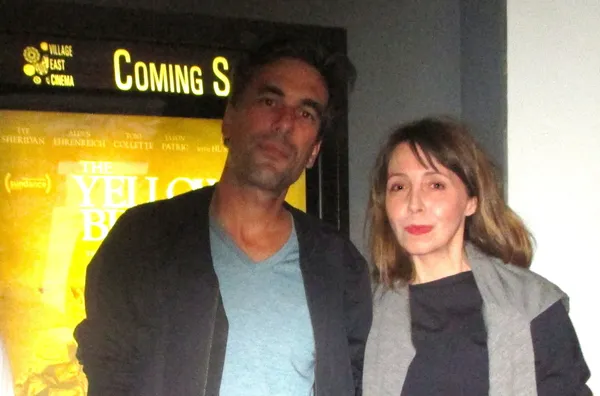Alexandre Moors, before the theatrical première of The Yellow Birds "Director's Cut" and the post-screening discussion on opening night in New York with him and Ronnie Porto (co-screenwriter, with David Lowery, of the adaptation of the novel by Kevin Powers), spoke with me about the casting of Alden Ehrenreich and Tye Sheridan for the roles of the two young soldiers.
Production designer Annie Beauchamp, the dressing of Jennifer Aniston and Toni Collette by Ann Roth, Clément Cogitore's ghostly war film Neither Heaven Nor Earth (Ni Le Ciel Ni La Terre), Donna Maloney in Morocco, playing with the Garden of Eden, the descent from the cross, and what colour might be coming up for Alexandre after Blue Caprice and The Yellow Birds flew into our conversation.
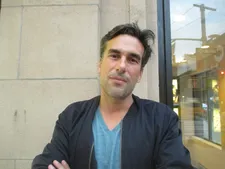 |
| Alexandre Moors: "Well, I loved Tye Sheridan in a movie called Joe with Nicolas Cage. He was amazing." Photo: Anne-Katrin Titze |
Anne-Katrin Titze: Alden Ehrenreich and Tye Sheridan are good together. Now they are galloping to superstardom. I had first noticed them in very different roles: Alden Ehrenreich in Hail Cesar! and Tye Sheridan in Jeff Nichols' Mud. How did those two get to be in your film?
Alexandre Moors: Well, I loved Tye Sheridan in a movie called Joe with Nicolas Cage. He was amazing. Tye Sheridan was in the project as long, if not longer than me. He's been carrying the project for years. He met with Kevin Powers, he was very invested. He was 17, he was really a kid. So he really embodied that character. And Alden … We had another actor attached. He dropped out a month before we shot, so I had to recast, which I was very happy about.
I had just a few weeks to look at every 20-year-old actor in America. I picked Alden even before watching his movies. I saw an interview that he gives on the red carpet. It's a stupid thing where the MTV girl is like "How do you think, blah-blah …" And his response! He was absolutely not playing the game. He was just fantastic. I thought, I want this guy. This guy is going to be a huge star.
AKT: And you were right! It's also that both of them are not soldierly. They come across as so alive that it's heartbreaking what happens to them in the story. I think that translates to audiences for the bigger picture of war and home life. What does Bartle have to look forward to?
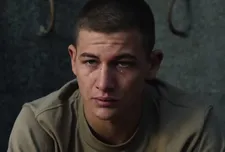 |
| Tye Sheridan as Daniel Murphy: "He's been carrying the project for years. He met with Kevin Powers, he was very invested." |
AM: Absolutely. It's kind of a snapshot of a country that disappears. In the same way that the future disappears. There's no guidance, nothing to look forward. There's no narrative, no dream that can guide their life.
AKT: Just look at last week. The suicides everywhere in the news. From 1999 until 2016 the suicide rates, according to a study, went up 25%.
AM: Yeah, just this weekend I was having the same conversation with one of my journalist friends. She wanted to write about this. The last four years the numbers are skyrocketing.
And we were arguing. For me it's something that is very specifically for America. Because there is no more narrative to drive this country. There's nothing to look forward. The words don't mean anything. It's a desolate landscape. It's terrifying.
AKT: Just coming here on the subway, everybody is isolated.
AM: Everybody is by themselves, yeah. That was the research that we did. That was my first question. How come there was no PTSD in World War II? Not to that level, you know. Even though the people saw far greater massacre. There was trauma but just the statistics of the rates of suicides by soldiers were vastly inferior.
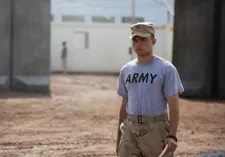 |
| Alexandre Moors on picking Alden Ehrenreich for Brandon Bartle: "I thought, I want this guy. This guy is going to be a huge star." |
The answer was that the society they returned to was different. And now you return to a society where it's so isolated. Where people, you said it exactly, don't even look at each other. You can just disappear.
AKT: You show that in the scene where Bartle buys beer. The clerk, that other boy, who is there and almost as miserable as the one who returned from the war. It doesn't even need the war experience to have that kind of misery. That's one of the points, isn't it?
AM: With that young boy? I liked the idea that the boy was almost the next in kind.
AKT: The next in line?
AM: Yeah.
AKT: Did you at times slow down the film and at others speed it up?
AM: Yes.
AKT: To disorient us? I liked that effect.
AM: Or sometimes the pacing is wrong. Like the woman in black. When she is walking around she is always in slow-motion. Because she looks more like she is floating. I can't remember which other places.
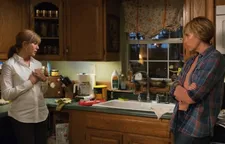 |
| Maureen Murphy (Jennifer Aniston) with Brandon's mother Amy (Toni Collette) |
AKT: Did you see Neither Heaven Nor Earth, Clément Cogitore's film? It is another war film that is using powerful disorienting visuals.
AM: Ah, no. It came out last year? It's French?
AKT: Yes, Ni Le Ciel Ni La Terre. I believe it was at Cannes in 2015.
AM: It's always so hard in America to watch some of those European films. I need to watch it.
AKT: Ann Roth has shared credit for the costumes. She is the greatest.
AM: I was such a fan! As a film buff, when I met her … What can I say? She did the costumes of Marathon Man, which is one of my favourite movies. And Midnight Cowboy. So we clicked right away.
AKT: She dressed the women?
AM: She dressed mostly Jennifer Aniston and the women in America. Donna [Maloney] went to Morocco. She [Roth] was a great asset not only because she is extremely talented but also she has the prestige dealing with some of those big actresses.
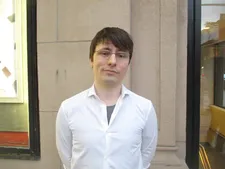 |
| Ronnie Porto aka RFI Porto, co-screenwriter of The Yellow Birds with David Lowery Photo: Anne-Katrin Titze |
Sometimes she would second my opinion, you know what I mean? I could say "You should not wear this or this." She was a great asset because she is very honest. She speaks very freely.
AKT: Ann Roth also did the costumes for The Seagull, the Chekhov adaptation, and the director Michael Mayer told me that she put crumbs into the jacket pockets of the actor Brian Dennehy for his character. That's how detail-oriented she is.
AM: Yeah, she put change in the pockets. Little things. Her approach is really just character-driven. The questions she asked me as the director, you know - "What do you think Maureen [Aniston's character] was wearing at her prom?" She really tried to get under the skin of the character. And you're like, whoa, I haven't done my homework.
AKT: She made the Jennifer Aniston character into something like the 21st century Doris Day, in the best sense. I never thought of the two actresses together. For Maureen everything looks perfect in a certain military sense. And she is trying so hard to fill out the hollowness. She clearly dearly loves her son. Her husband is more throwaway.
AM: Yeah.
AKT: And Toni Collette's character - the costumes are also perfect for somebody whose son is slightly ashamed of where he comes from. It's all of that heartbreak. There's one shot I was wondering about. The two women are in the living room and we see a big yellow vase in the foreground. This gigantic yellow vase?
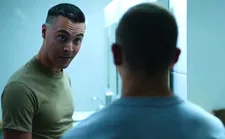 |
| Sergeant Sterling (Jack Huston) and Murph (Tye Sheridan): "They're fighting ghosts. But they already crossed. They're on the other side." |
AM (laughing): I have no idea!
AKT: There's nothing to it? It's not an urn? No symbolism?
AM: No. But again, once you infuse that spirit to the crew, the film is a collective enterprise. When you have those preparation meetings and people see what approach you have, everybody just contributes.
And Annie Beauchamp, who is the production designer, she is amazing and she'll start doing that. She'll start putting objects. I'm like "What is that?" And she's like "No, no, trust me!" You know what I mean? We can play.
AKT: Some of the imagery that is more obvious is in the Christ layouts.
AM: Iconographies.
AKT: Right. The girl on the stretcher and later on also. You play with the Garden of Eden and are alluding to them being Christ figures.
AM: Absolutely, yeah. But you are the first person who said that.
AKT: I am?
AM: I guess there could have been more of it. All the visual iconography, even the visual tone, the sepias, the earth, felt like sienna. You know, classic Renaissance. La descente de croix. The taking down of the Christ from the cross.
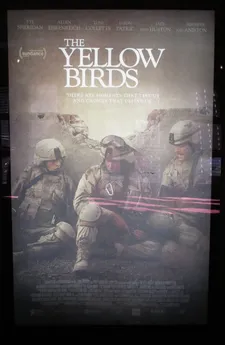 |
| The Yellow Birds poster at the Village East Cinema in New York Photo: Anne-Katrin Titze |
AKT: The descent from the cross, yes. I felt that very much. I don't know how to phrase this, but I am not exactly sure what happened to Murphy in the end. Am I supposed to not exactly know?
AM: Ah, interesting. Factually?
AKT: Yes.
AM: We had a version where it was a little bit more explicit in Sundance.
AKT: It's the kind of wounds that could be both.
AM: And it is, no matter what, a death wish. Even the disappearance. It cannot be completely solved. It's a little magic, it's also a little esoteric. Also I don't know if you noticed, the more you go into the movie, there's no more enemies. The only enemies you see are the first battle in the first 20 minutes.
And then after that you don't see them, they're just dead or they don't exist anymore. Things just explode or soldiers disappear. It's just the landscape that swallows them.
AKT: The burning palm tree?
AM: Exactly. They're fighting ghosts. But they already crossed. They're on the other side. You know, they're in limbo. So we couldn't be too specific what happened.
AKT: Well, it doesn't matter, really. The strangeness is also part of that horror that Bartle carries with him. There is no big reveal.
AM: That's the problem at least with some audiences. The film is a mystery but unfortunately it's not an enigma. There's no satisfaction by unearthing the answer. Usually in mystery films when you find a clue there's a resolution. Here it just opens up more doors, more traps.
AKT: What's coming up for you?
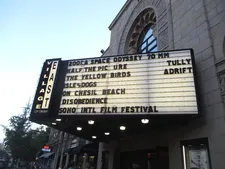 |
| Village East Cinema marquee The Yellow Birds Photo: Anne-Katrin Titze |
AM: I have three movies in various stages. What I learned from my first to the second is that movie productions take their sweet time. It's good to have different films in different stages in the pipeline. Otherwise you end up waiting by the phone for an actor to call and that drives you crazy. I have one that we're casting right now but I'm trying not to think about it because it's so out of my power.
AKT: Does any one of them have a colour in the title?
AM: Ah, funny, I was thinking about that on my way here. One is called Buddy Fox, which is the one I'm writing right now. I'm just starting. I thought, I have to call it The Brown Fox. Or Robert Brown. Chestnut Brown. Instead of having the colour as an adjective, I was like, I'm going to change and have this guy's last name be ...
AKT: Brown?
AM: And I was like, damn, I hope it's the next one I make.
AKT: Your colour trilogy. It's like Kieslowski. Red, White, and Blue.
AM: Exactly. And it has also like …
AKT: Snipers?
AM: There's no snipers. But it's about mental health and mental illness in America. It's the story of a father who becomes schizophrenic and his daughters then have to deal with that situation. So it's again very similar.
Read what Alexandre Moors had to say on the director's cut of The Yellow Birds, Story Mining & Supply's Jeffrey Sharp's role in getting David Lowery involved, the connection to the performances of Isaiah Washington and Tequan Richmond in Blue Caprice, how Jason Patric created Captain Anderson, and using Kevin Powers' novel as a starting point to expand the territory of war films.
?The Yellow Birds? is in cinemas in the US.








